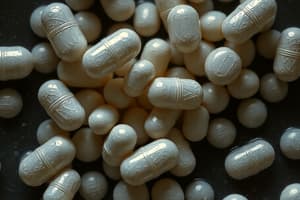Podcast
Questions and Answers
Which antibiotic is contraindicated in patients with renal or liver impairment?
Which antibiotic is contraindicated in patients with renal or liver impairment?
- Levofloxacin
- Rifampicin
- Cloxacillin
- Metronidazole (correct)
Which antibiotic is specifically good for MRSA infections?
Which antibiotic is specifically good for MRSA infections?
- Vancomycin (correct)
- Ofloxacin
- Rifampicin
- Cloxacillin
Which antibiotic works by inhibiting the second stage of cell wall peptidoglycan synthesis by binding to a specific peptide side chain?
Which antibiotic works by inhibiting the second stage of cell wall peptidoglycan synthesis by binding to a specific peptide side chain?
- Vancomycin (correct)
- Rifampicin
- Ofloxacin
- Cloxacillin
Which antibiotic is known to increase the formation of reactive oxygen species to produce breaks in bacteria's DNA?
Which antibiotic is known to increase the formation of reactive oxygen species to produce breaks in bacteria's DNA?
Which antibiotic is time-dependent and functions by inhibiting the synthesis of peptidoglycan in the cell wall?
Which antibiotic is time-dependent and functions by inhibiting the synthesis of peptidoglycan in the cell wall?
Which antibiotic works by nicking and relaxing the DNA supercoiled for DNA replication?
Which antibiotic works by nicking and relaxing the DNA supercoiled for DNA replication?
Which of the following antibiotic classes is characterized by their concentration-dependent activity against gram-negative bacilli and staphylococci?
Which of the following antibiotic classes is characterized by their concentration-dependent activity against gram-negative bacilli and staphylococci?
What is the primary mechanism of action of beta-lactamase inhibitors?
What is the primary mechanism of action of beta-lactamase inhibitors?
Which of the following antibiotics is a monobactam?
Which of the following antibiotics is a monobactam?
What is a common side effect of aminoglycoside antibiotics?
What is a common side effect of aminoglycoside antibiotics?
What is the primary route of administration for aminoglycoside antibiotics?
What is the primary route of administration for aminoglycoside antibiotics?
Which of the following antibiotic combinations is used to protect against beta-lactamase degradation?
Which of the following antibiotic combinations is used to protect against beta-lactamase degradation?
Flashcards are hidden until you start studying
Study Notes
Antibiotics that Interfere with DNA Synthesis
- Metronidazole increases formation of reactive oxygen species (free radicals) to produce breaks in bacteria's DNA.
- It enters bacteria via cell diffusion.
- Contraindicated in patients with renal or liver impairment.
- Effective against anaerobes, protozoans (Entamoeba histolytica, Giardia lamblia, and Trichomonas vaginalis), and most gram-negative and gram-positive anaerobic bacteria.
- Often used due to bacterial resistance to amoxicillin and tetracycline or due to intolerance (H. pylori).
Rifampicin and Fluoroquinolones
- Rifampicin is used for treatment of TB.
- Fluoroquinolones have concentration-dependent killing and nick and relax DNA supercoiled for DNA replication.
- Topoisomerases II are inhibited in gram-negative bacteria, while Topoisomerases IV are inhibited in gram-positive bacteria.
- First-generation fluoroquinolones include Ciprofloxacin and Ofloxacin (broad-spectrum drugs).
- Second-generation fluoroquinolones include Levofloxacin and Moxifloxacin (newer generation and better for gram-positive bacteria).
- Parent drug is Nalidixic acid (a quinolone).
Inhibitors of Cell Wall Synthesis
- Beta-lactams are time-dependent killing and inhibit peptidoglycan synthesis.
- Vancomycin is a glycopeptide that inhibits the second stage of cell wall peptidoglycan synthesis by binding to the D-alanyl-D-alanine precursor peptide side chain.
- Effective against MRSA infections, but contraindicated in patients with renal impairment.
- Penicillin allergic and has resistance to gram-positive bacteria.
Beta-Lactam Antibiotics
- Natural penicillins include Penicillin G potassium and Penicillin V phenoxy methyl.
- Penicillinase-resistant drugs include Cloxacillin and Methicillin.
- Amino-penicillins are extended drugs, effective against gram-positive and gram-negative organisms, and used for H. pylori.
- Amino-penicillins include Ampicillin and Amoxicillin.
- Ureidopenicillin includes Piperacillin.
- Cephalosporins include:
- First-generation: Cefazolin
- Second-generation: Cefuroxime and Cefoxitin
- Third-generation: Cefotaxime, Ceftriaxone, and Ceftazidime
- Fourth-generation: Cefepime and Cefpirome
- Carbapenems are a subclass of beta-lactams, used for treatment of severe infections of resistant bacteria, and include:
- Doripenem (Doribax)
- Imipenem (Primaxin)
- Meropenem (Merem)
- Ertapenem (Invanz)
Aminoglycosides
- Aminoglycosides are concentration-dependent, mainly administered intravenously, and have main activity against gram-negative bacilli and staphylococcal species.
- Systemic administration may lead to ototoxicity, nephrotoxicity, and respiratory depression.
- Reserved for severe systemic gram-negative infections.
- Excreted in topical ophthalmic use, but only for short therapy (5-7 days).
- Resistance occurs due to alteration of 30s subunit binding site, change in cell membrane permeability, and enzymatic inactivation.
- Adverse effects include vestibular and auditory dysfunction, nephrotoxicity (tubular necrosis), and respiratory depression (neuromuscular paralysis).
Beta-Lactamase Inhibitors
- Beta-lactamase inhibitors protect from the hydrolytic activity of beta-lactamases by "suicide" inactivation (inhibitor is hydrolyzed).
- Examples include:
- Amoxicillin-clavulanate
- Piperacillin-tazobactam
- Ampicillin-sulbactam
Studying That Suits You
Use AI to generate personalized quizzes and flashcards to suit your learning preferences.




